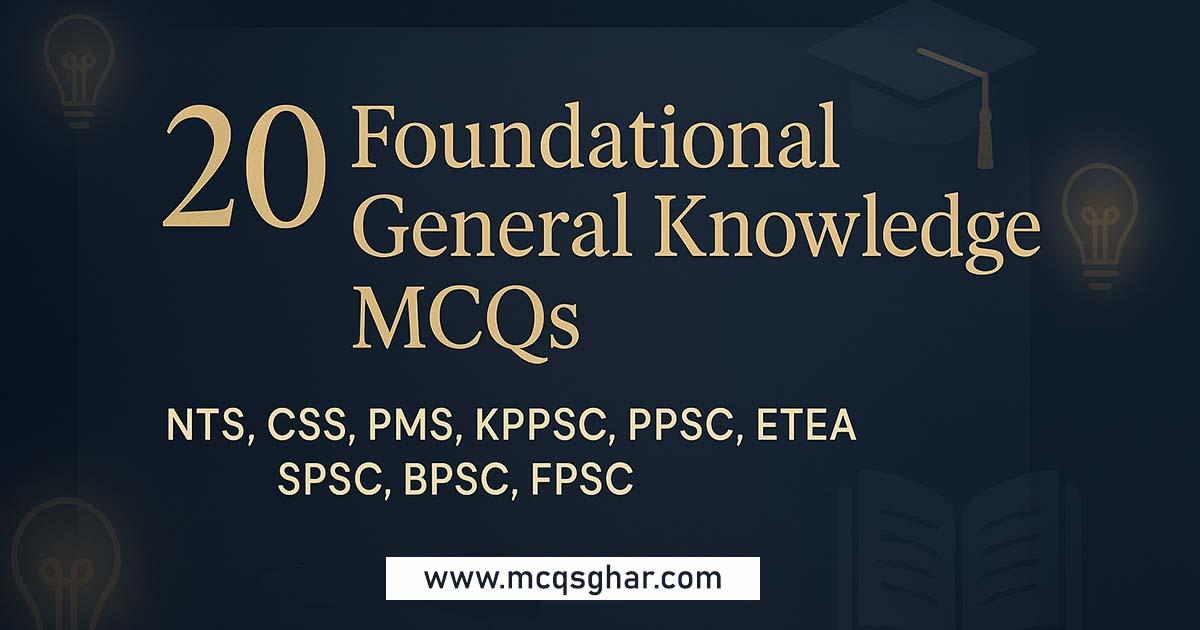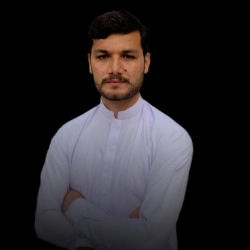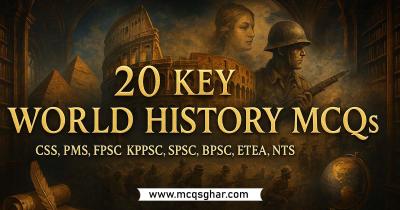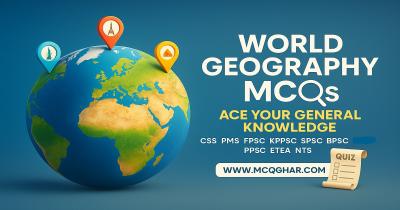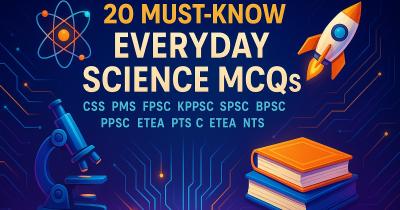بِسْمِ اللَّهِ الرَّحْمَنِ الرَّحِيم
20 Foundational General Knowledge MCQs for NTS, CSS, PMS, KPPSC, PPSC, ETEA, SPSC, BPSC, and FPSC Tests
The journey to success in competitive exams like NTS, CSS, PMS, KPPSC, PPSC, ETEA, SPSC, BPSC, and FPSC begins with a strong foundation in General Knowledge. This vast subject covers everything from world geography to landmark scientific discoveries. To help you build that solid base, we've curated 20 essential, evergreen MCQs that frequently appear in various exams. Master these, and you'll be one step closer to your goal. Let's begin!
1. Which country is nicknamed 'The Cockpit of Europe' due to the number of historical battles fought on its soil?
- Germany
- France
- Belgium
- United Kingdom
Answer: Belgium
Explanation: Belgium's strategic location in Western Europe has made it a battleground for centuries, from the Napoleonic Wars (Battle of Waterloo) to World War I and II. Its flat terrain provided an ideal route for armies marching between France and Germany.
2. The famous social networking site 'Facebook' was founded by:
- Bill Gates
- Steve Jobs
- Mark Zuckerberg
- Elon Musk
Answer: Mark Zuckerberg
Explanation: Mark Zuckerberg, along with his college roommates at Harvard University, launched Facebook in 2004. It has since grown to become one of the world's largest and most influential social media platforms.
3. Who discovered Penicillin in 1928?
- Alexander Fleming
- Louis Pasteur
- Marie Curie
- Robert Koch
Answer: Alexander Fleming
Explanation: The discovery of penicillin by Scottish physician-scientist Alexander Fleming was a watershed moment in medicine. It was the world's first broadly effective antibiotic, revolutionizing the treatment of bacterial infections and saving millions of lives.
4. The Palk Strait separates which two countries?
- India and Bangladesh
- India and Sri Lanka
- Pakistan and Iran
- Malaysia and Indonesia
Answer: India and Sri Lanka
Explanation: The Palk Strait is a strait between the Tamil Nadu state of India and the Jaffna District of the island nation of Sri LankIt connects the Bay of Bengal in the northeast with Palk Bay in the southwest.
5. How many pairs of ribs are there in a normal human body?
- 10
- 12
- 14
- 16
Answer: 12
Explanation: The human rib cage consists of 24 ribs in 12 pairs. They protect vital organs in the thoracic cavity, such as the heart and lungs. The first seven pairs are 'true ribs', the next three are 'false ribs', and the last two are 'floating ribs'.
6. What is the capital of Libya?
- Benghazi
- Misrata
- Sirte
- Tripoli
Answer: Tripoli
Explanation: Tripoli is the largest city and capital of Libya, located in the northwestern part of the country on the edge of the desert, on a point of rocky land projecting into the Mediterranean Sea.
7. Who is known as the father of the computer?
- Tim Berners-Lee
- Charles Babbage
- Alan Turing
- John von Neumann
Answer: Charles Babbage
Explanation: Charles Babbage, an English mathematician and inventor, is credited with originating the concept of a digital programmable computer. His designs for the Difference Engine and the Analytical Engine laid the groundwork for modern computing.
8. Which continent has no deserts?
- Australia
- South America
- Europe
- North America
Answer: Europe
Explanation: Europe is the only continent without a major desert. While some small, semi-arid regions exist, it lacks the large, arid desert landscapes found on every other continent (excluding Antarctica, which is a polar desert).
9. The Gobi Desert extends over which two countries?
- China and Mongolia
- Russia and Kazakhstan
- India and Pakistan
- Iran and Afghanistan
Answer: China and Mongolia
Explanation: The Gobi Desert is a large desert and brushland region in East AsiIt covers parts of Northern and Northeastern China and of Southern MongoliIt is a rain-shadow desert, formed by the Himalaya mountains blocking rain-carrying clouds from the Indian Ocean.
10. What is measured by an ammeter?
- Voltage
- Resistance
- Electric current
- Power
Answer: Electric current
Explanation: An ammeter (from Ampere Meter) is a measuring instrument used to measure the electric current in a circuit. Electric currents are measured in amperes (A), hence the name. It is always connected in series in the circuit where the current is to be measured.
11. The Khyber Pass links which two countries?
- Pakistan and Iran
- Pakistan and China
- Pakistan and Afghanistan
- India and Nepal
Answer: Pakistan and Afghanistan
Explanation: The Khyber Pass is a historic mountain pass in the northwest of Pakistan, on the border with Afghanistan. It has been a crucial trade route and strategic military location for centuries, connecting Central Asia and the Indian Subcontinent.
12. There are a total of ___ UN Sustainable Development Goals (SDGs).
- 15
- 17
- 19
- 20
Answer: 17
Explanation: The 17 Sustainable Development Goals (SDGs) were adopted by all United Nations Member States in 2015 as a universal call to action to end poverty, protect the planet, and ensure that all people enjoy peace and prosperity by 2030.
13. A nephron is the functional unit of which organ in the human body?
- Liver
- Lungs
- Brain
- Kidney
Answer: Kidney
Explanation: The nephron is the microscopic structural and functional unit of the kidney. Its chief function is to regulate the concentration of water and soluble substances like sodium salts by filtering the blood, reabsorbing what is needed, and excreting the rest as urine.
14. What is the longest river in the world?
- Amazon
- Nile
- Yangtze
- Mississippi
Answer: Nile
Explanation: The Nile River, located in Africa, is credited as the longest river in the world, flowing for approximately 6,650 kilometers. It flows northward through northeastern Africa to drain into the Mediterranean SeThe Amazon River in South America is a very close second and is the largest by discharge volume.
15. The world's first underground train service was opened in 1863 in which city?
- New York
- Paris
- London
- Berlin
Answer: London
Explanation: The London Underground, or 'the Tube', is the oldest underground railway in the worlThe first section of the Metropolitan Railway opened to the public on January 10, 1863, running between Paddington and Farringdon Street.
16. Which country is the world's largest producer of coffee?
- Vietnam
- Colombia
- Brazil
- Ethiopia
Answer: Brazil
Explanation: Brazil has been the world's largest producer of coffee for over 150 years. The country's climate and geography are ideal for growing both Arabica and Robusta coffee beans.
17. The study of insects is known as:
- Entomology
- Ornithology
- Herpetology
- Ichthyology
Answer: Entomology
Explanation: Entomology is the scientific study of insects, a branch of zoology. Ornithology is the study of birds, herpetology is the study of reptiles and amphibians, and ichthyology is the study of fish
18. Mount Logan is the highest peak in which country?
- United States
- Mexico
- Canada
- Russia
Answer: Canada
Explanation: Mount Logan is the highest mountain in Canada and the second-highest peak in North America, after Denali. It is located within Kluane National Park and Reserve in southwestern Yukon.
19. Which of the following is NOT a member of SAARC?
- Afghanistan
- Myanmar
- Bhutan
- Maldives
Answer: Myanmar
Explanation: The South Asian Association for Regional Cooperation (SAARC) has eight member states: Afghanistan, Bangladesh, Bhutan, India, Maldives, Nepal, Pakistan, and Sri LankMyanmar is a member of ASEAN, not SAARC.
20. What is a rhinoceros's horn made of?
- Bone
- Ivory
- Keratin
- Cartilage
Answer: Keratin
Explanation: A rhinoceros horn is not made of bone, but of keratin, the same protein that makes up human hair and fingernails. This is a crucial fact in conservation efforts, as it debunks myths about its medicinal properties.
We hope this set of foundational MCQs has been helpful. Keep practicing, stay consistent, and explore our other posts for more specialized topics. Good luck!
